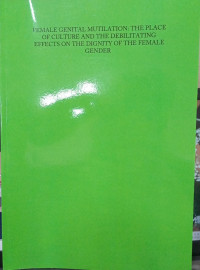
Text
Female Gental Multilation: The Place of Culture and the Debilitating Effects the Dignity of the Female Gender
Female genital mutilation (FGM) has four major types which arise from the degree to which the external genitalia of the female are affected. Its origin is shrouded with mysteries but historical evidences point to Egypt as the source country, before its spread through countries in sub-Saharan Africa, Asia, the Middle East, as well as some migrants in Europe, United States and Australia. Reasons for carrying out the practice range from ethnic and tribal cultures, family relations, tribal connections, class, economic and social circumstances; and education etc. The effects on the affected young girls and women may be short term (severe pain, shock, haemorrhage (bleeding), tetanus or sepsis (bacterial infection), urine retention, open sores in the genital region and injury to nearby genital tissue and sometimes death); or long term (physical, sexual and psychological). Different nations in the affected regions have enacted one law or the other at a point in time in their history to curb this degrading menace but the prevalence data shows that the practice is far from being eradicated. The discourse brings to the fore, the implications of FGM practice on the dignity of the female gender and proposes an annihilation of this dastardly act.
Availability
| KP XVIII 0018 | 617.46 Int F | Perpustakaan Komnas Perempuan (Perpustakaan Komnas Perempuan) | Available |
Detail Information
- Series Title
-
-
- Call Number
-
617.46 Int F
- Publisher
- : European Scientific Journal., 2015
- Collation
-
97 hlm; 30 cm
- Language
-
English
- ISBN/ISSN
-
1857-7881
- Classification
-
617.46
- Content Type
-
-
- Media Type
-
-
- Carrier Type
-
-
- Edition
-
-
- Subject(s)
- Specific Detail Info
-
-
- Statement of Responsibility
-
-
Other version/related
No other version available
File Attachment
Comments
You must be logged in to post a comment
 Computer Science, Information & General Works
Computer Science, Information & General Works  Philosophy & Psychology
Philosophy & Psychology  Religion
Religion  Social Sciences
Social Sciences  Language
Language  Pure Science
Pure Science  Applied Sciences
Applied Sciences  Art & Recreation
Art & Recreation  Literature
Literature  History & Geography
History & Geography